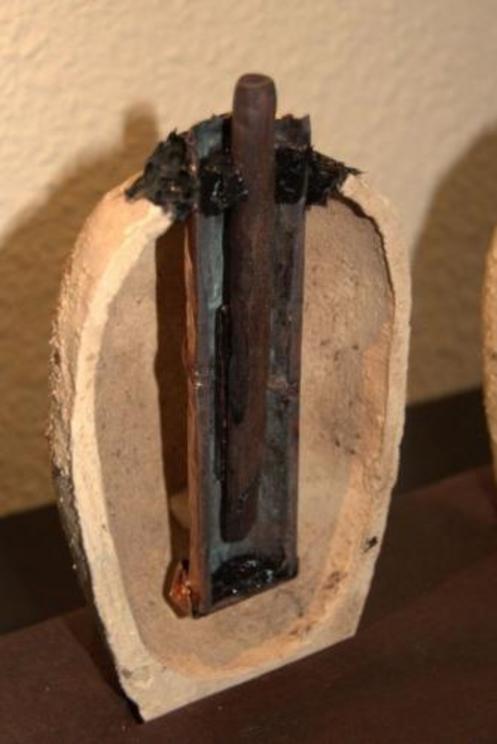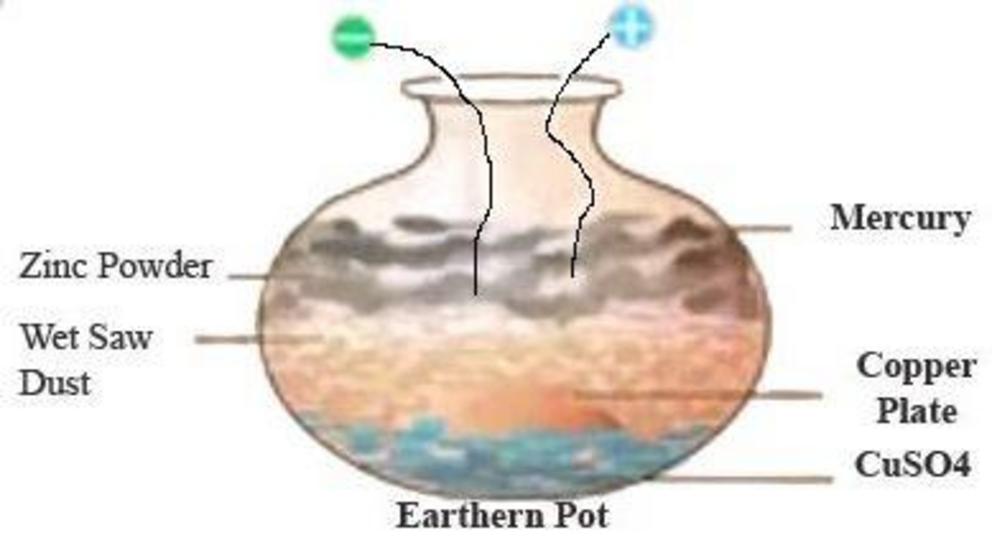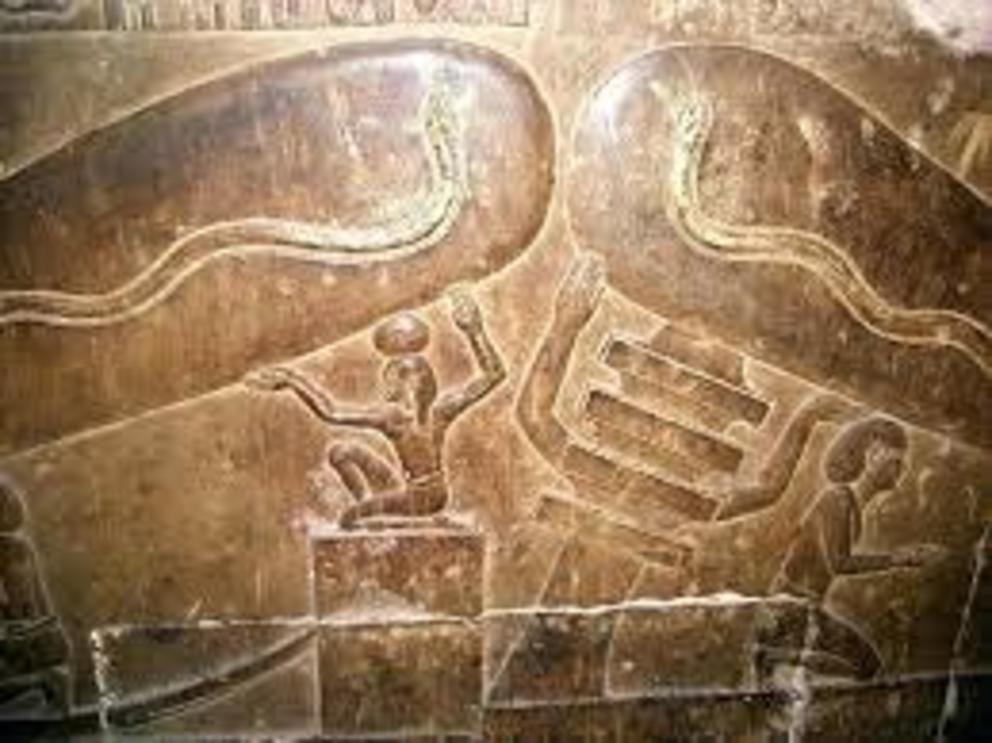Making the case for ancient electricity
IN 1938-39 a German archaeologist Wilhelm Konig found near Baghdad a number of earthenware jars with necks covered with asphalt and iron rods encased in copper cylinders. Konig described his find in the Austrian Scientific Journal Jahre lrak in 1940. He thought they were electric batteries, but electric batteries from ancient Babylon? The idea was far too fantastic; it needed corroboration.

Cross section of Prof Konig’s Baghdad battery clearly showing a simple power cell construction.
After World War II Willard Gray of the General Electric Company made a duplicate of the 2ooo-year-old battery, filling it with copper sulphate instead of the unknown original electrolyte which had evaporated. The sister-battery of the ancient Babylonian vase-shaped cell was tested and it worked! This was conclusive proof that the Babylonians did indeed use electricity. In as much as a number of electro-plated articles had been excavated in the same general area, it was assumed that one of the purposes of the battery was electro-plating.
Similar jars have been found in the remains of a magi’s hut and it can be surmised that both priests and craftsmen kept the knowledge of ancient electricity as a trade secret. The date of the electroplated materials mentioned above is around 2000 B.C, that is they were two thousand years older than Konig’s ceramic cells. It should be noted here that electroplating and galvanization were introduced only in the first part of the 19th century, demonstrating clearly how a certain technological process used four thousand years ago, was rediscovered in modern times.
The presence of batteries in ancient Babylon indicates that some knowledge of the principles of electricity must have existed in antiquity. Electrical devices may explain reports by ancient devotees, of mysterious flashes of light coming from eyes of the statue of Isis in the Temple of Karnak, indeed many classical authors have made statements in their works testifying to the reality of ever-burning lamps in anicent times Unfortunately, there is no way of finding out if these lamps shone by electric light or some other energy.
Possible descriptions of ‘ancient electricity’ usage
- Numa Pompilius, the second king of Rome, had a perpetual light shining in the dome of his temple.
- PIutarch wrote of a lamp which burned at the entrance of a temple to Jupiter-Ammon, and its priests claimed that it had remained alight for centuries.
- Lucian (A,D. 120-180), the Greek satirist, gave a detailed account of his travels. In Hierapolis, Syria he saw a shining jewel in the forehead of the goddess Hera which glowed brilliantly and illuminated the whole temple at night. In the same locale the temple of Hadad or Jupiter in Baalbek was provided with another type of lighting, glowing stones.
- A beautiful golden lamp in the temple of Minerva which could burn for a year, was described by Pausanias (end century).
- Saint Augustine (A.D. 354-430) left a description of a wonder-lamp in one of his works. It was located in Egypt in a temple dedicated to Isis, and St. Augustine says that neither wind nor water could extinguish it.
- An ever-burning lamp was found at Antioch during the reign of Justinian of Byzantium (6th century). An inscription indicated that it must have been· burning for more than five hundred years.
- During the early Middle Ages a 3rd-century perpetual lamp was found in England and it had burned for several centuries.
- When the sepulchre of Pallas, son of Evander, immortalized by Virgil in his Aeneid, was opened near Rome in 1401, the tomb was found to be illuminated by a perpetual lantern which had been alight for more than two thousand years.
- A sarcophagus, containing the body of a young woman of patrician stock, was found on the Via Appia near Rome in April, 1485. When the dark ointment preserving the body from decomposition had been removed, the girl looked lifelike with her red lips, dark hair and shapely figure. It was exhibited in Rome and seen by twenty thousand people. When the sealed mausoleum was opened a lighted lamp amazed the men who broke in. It must have been burning for one thousand five hundred years!
- In his Oedipus Aegyptiacus (Rome; 1652) the Jesuit Kircher refers to lighted lamps found in the subterranean vaults of Memphis.
Surely we cannot discount all these ancient descriptions as fantasy? It is evident from the Babylon batteries alone that electricity was known about in the remote past albeit a closely guarded secret known only to the elite few.
Technology of ancient India

The electric cell as described in the Agastya Samhita
We look now to the culture of ancient India for more clues concerning the use of electricity in ancient times. The Indian’s arguably possess the oldest unbroken cultural tradition in existence today, the origins of which stretch back well over 8000 years. There are numerous clues in their primary texts such as the Mahabharata which seem to indicate knowledge of advanced scientific understanding. One such document is preserved in the Indian Princes’ Library at Vjjain and listed as Agastya Samhita which contains instructions for making electrical batteries:
‘Place a well-cleaned copper plate in an earthenware vessel. Cover it first by copper sulphate and then by moist sawdust. After that put a mercury-amalgamated zinc sheet on top of the sawdust to avoid polarization. The contact will produce an energy known by the twin name of Mitra-Varuna. Water will be split by this current into Pranavayu and Udanavayu. A chain of one hundred jars is said to give a very active and effective force.’
The Mitra-Varuna is now called cathode-anode, and Pranavayu and Udanavayu is to us oxygen and hydrogen. This document again demonstrates the presence of ancient electricity in the East, long, long ago.
In the temple of Trevandrum, Travancore Rev. S. Mateer of the London Protestant Mission saw ‘a great golden lamp which was lit over one hundred and twenty years ago’, in a deep well inside the temple.
Discoveries of ever-burning lamps in the temples of India and the age-old tradition of the magic lamps of the Naga-the serpent gods and goddesses who live in underground abodes in the Himalayas, raises the possibility of the use of electric light in a forgotten era and when backed up by such compelling passages as described in the Agastya Samhita text giving precise directions for constructing electrical batteries, this is not idle speculation.
History shows that the priests of India, Sumer, Babylon, Egypt as well as their counterparts on the other side of the Atlantic in Mexico and Peru, were custodians of a scientific tradition that is lost to us now. It appears likely that in some remote epoch perhaps at the end of the last Ice Age in accordance with the ideas put forwards by Graham Hancock and others, learned individuals were forced to withdraw into inaccessible parts of the world to save their accumulated knowledge from the ravages of war or geological upheavals. We are still not certain as to what happened in Crete, Gobekli- Tepi or the Yucatan and why these sophisticated civilizations suddenly came to an end, but that advanced technology was known, technology that has only been re-discovered by us in the last 100 years is surely not in doubt?
Forgotten Technologies of the Pacific
The understanding of ancient electricity is not confined to the classical world and the Americas either: Tibet was also known to have had miraculous lamps that burned for long periods. Father Evariste-Regis Hue (1813- 1860) who travelled extensively in Asia during the 19th century left a description of one of the ever-burning lamps which he had seen himself in that country. In Australia too, tradition tells of a village in the jungle near Mt. Wilhelmina, in the Western half of New Guinea or Irian. Cut ‘off from civilization, this village has ‘a system of artificial illumination equal, if not superior, to the 2oth century’, as one C. S. Downey stated ata conference on Street Lighting and Traffic in Pretoria, South Africa in 1963-
Traders who penetrated this small hamlet lost amidst high mountains, said that they ‘were terrified to see many moons suspended in the air and shining with great brightness all night long’.” These artificial moons were huge stone balls mounted on pillars. After sunset they began to glow with a strange neon-like light illuminating all the streets.
Ion Idriess is a well-known Australian writer who has lived among the Torres Strait islanders. In his ‘Drums Of Mer’ he tells of a story about the ‘booyas’ which he received from the old aborigines. A booya is a round stone set in a large bamboo socket. There were only three of these stone sceptres known in the islands. When a chief pointed the round stone towards the sky, a thunderbolt of greenish-blue light flashed. This ‘cold light’ was so brilliant that the spectators seemed to be enveloped in it.
Since Torres Strait washes the shores of New Guinea, one can perceive some connection between these ‘booyas’ and the ‘moons’ of Mount Wilhelmina.
Tales of similar shining stones come’ to us from the other side of the Pacific South America. Barco Centenera, a journal keeper for the conquistadors, wrote about their discovery of the city of Gran Moxo near the source of Paraguay River in the Matto Grosso. In a work dated 1601 he paints the picture of this island city and says: ‘On the summit of a 71 metre pillar was a great moon which illuminated all the lake, dispelling darkness.’

In 1925 explorer Percy Fawcett disappeared in the Amazon looking for evidence of the lost civilization of Z
credit: CNN
Seventy years ago Colonel P. H. Fawcett was told by the natives of the Matto Grosso that mysterious cold lights had been seen by them in the lost cities of the jungle. Writing to the British author Lewis Spence he said: ‘These people have a source of llumination which is strange to us in fact, they are a remnant of civilization which has gone and which has retained old knowledge.’ Fawcett was in search of ruins of that vanished civilization, and he made claim to having seen a lost city in the jungle. We can believe in Colonel Fawcett’s sincerity because he sacrificed his life in that expedition.
Any denial that the utilisation of electricity is anything other a new discovery must surely derided as a case of pernicious debunking- the Baghdad batteries and evidence of electro-plating in the middle east 4000 years ago shows us that. The real question is, where did this knowledge come from? If such knowledge was an organic discovery then one would expect to see consistent and widespread references to its usage, in art, wall friezes literature and such. In fact our civilisation would have developed at a far quicker rate if ancient electricity usage was widespread. The written accounts that we do have suggest something rare, something to be marveled at, something to be guarded.
It is my belief that the knowledge of ancient electricity was a closely guarded secret, handed down via initiated groups or secret societies – (think priesthoods and craft guilds such as the Freemasons). This knowledge was part of a tradition inherited from a much earlier source , a pre-deluvian civilisation lost in the mists of time. The ancients (Indian Vedic tradition excepted) probably didn’t even understand the theory behind the science of electricity, only that is was some sort of powerful magic inherited from the time of the Gods and hence to be kept secret, known only to the initiated. These are provocative and intriguing ideas that challenge our own understanding of the history that we have been taught at school but it would be wrong to dismiss these ideas as pure fantasy, we ignore the wisdom of our ancestors at our peril.
Extracts from Andrew Tomas’s We Are Not The First

